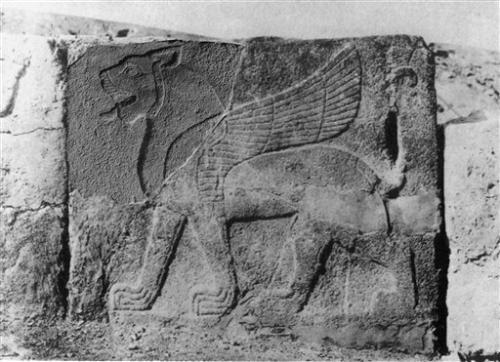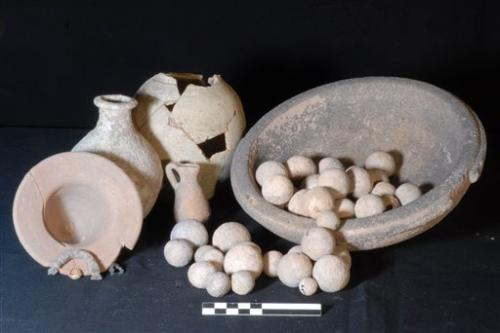PART.2

In this image made available by the Joint Turco-Italian Archaeological Expedition, on Nov. 1, 2012 shows a file photo, of a reconstruction of the lion head fragment set into the slab now in the Anatolian Civilizations Museum in Ankara, Turkey. Few archaeological sites seem as entwined with modern conflict as the ancient city of Karkemish, itself the scene of a battle mentioned in the Bible. Smack on the border between Turkey and Syria, where civil war rages, Turkish sentries have long occupied the acropolis and the ruins were recently demined. Visible from earthen ramparts, a Syrian rebel flag flies in a town that regime forces fled months ago.(AP Photo/Joint Turco-Italian Archaeological Expedition, File)
The Bible's Jeremiah refers to Karkemish for a battle there in which the Babylonians, led by Nebuchadnezzar II, defeated the Assyrians and their Egyptian allies. Invading forces sacked the city on several other occasions. Irene Winter, an archaeologist who visited Karkemish in 1974 and recently retired from Harvard University, said the place was significant as a "hub of all east-west traffic" and "a powerful, crucial juncture in the topography of movement and trade and military activity."
In the ruins of the excavation house of its British predecessors, the Turkish-Italian team discovered old archaeological tools, statue fragments and a Roman mosaic. Elsewhere, they found a bronze cylinder seal inscribed with hieroglyphs that belonged to a town official and a bronze statuette of a god with a double-horned tiara and a skirt, along with a silver dagger set into the left hand.

This is a Joint Turco-Italian Archaeological Expedition Nov. 2, 2011 file photo, showing experts working on protecting through ethyl-silicate decayed mudbrick walls in King's Gate area, in background the Great Staircase and the acropolis of Karkemish in Gaziantep province, Turkey. Few archaeological sites seem as entwined with modern conflict as the ancient city of Karkemish, itself the scene of a battle mentioned in the Bible. Smack on the border between Turkey and Syria, where civil war rages, Turkish sentries have long occupied the acropolis and the ruins were recently demined. Visible from earthen ramparts, a Syrian rebel flag flies in a town that regime forces fled months ago. (AP Photo/Joint Turco-Italian Archaeological Expedition, File)
"You do feel a connection with what has been written, with what has been found and, of course, with the people who were here," said Marchetti, whose team used a laser scanner to create digital models of artifacts. It got a more complete picture with satellite imagery as well as aerial photos taken from a kite.
The British only excavated a small area of Karkemish, and the Turkish military occupation shielded the site from smugglers, suggesting its archaeological potential remains vast. Despite the many finds, there are gaps in the understanding of the city's chronology.
Philologist Hasan Peker of Istanbul University, deputy director of the project, said he hoped to find the city's "royal archives" dating from the height of the Hittite empire more than 3,000 years ago. The team has asked the Turkish military for access to the acropolis, where a watch tower stands.

In this image made available by the Joint Turco-Italian Archaeological Expedition,shows a Nov. 6, 2011 file photo, of funerary assemblage with glazed jars, stone weights, bronze fibulae and granulated gold earring from two cremation burials in a pithos in the Outer Town of Karkemish are seen in Gaziantep province, Turkey. Few archaeological sites seem as entwined with modern conflict as the ancient city of Karkemish, itself the scene of a battle mentioned in the Bible. Smack on the border between Turkey and Syria, where civil war rages, Turkish sentries have long occupied the acropolis and the ruins were recently demined. Visible from earthen ramparts, a Syrian rebel flag flies in a town that regime forces fled months ago.(AP Photo/Joint Turco-Italian Archaeological Expedition, File)
A demining agency from Azerbaijan helped Turkey to remove anti-tank and anti-personnel mines around Karkemish under a program to rid the nation's borders of minefields, mostly near Syria. There remains a statistical risk of mine blasts, however remote. The new team, which includes university students, sticks to approved paths. Plans for tourist facilities include paths with rails on both sides to ensure the safety of visitors.
In 2009 and 2010, professor Tony Wilkinson, an archaeologist at Durham University in Britain, participated in a survey of the Syrian side of Karkemish. He could not return in 2011 because of the uprising. As late as May this year, Wilkinson said, Syrian colleagues from the archaeological museum in Aleppo reported that they were checking the Karkemish site.
Since then, fierce fighting has swept Aleppo. Contact has faded. Last month, Wilkinson received a nighttime telephone call from Syria.
"It didn't get through. They tried to call me and I tried to call back," he said. "Communications with Syria are very, very difficult."
Suzan Fraser contributed from Ankara, Turkey.
Copyright © 2012 The Associated Press.